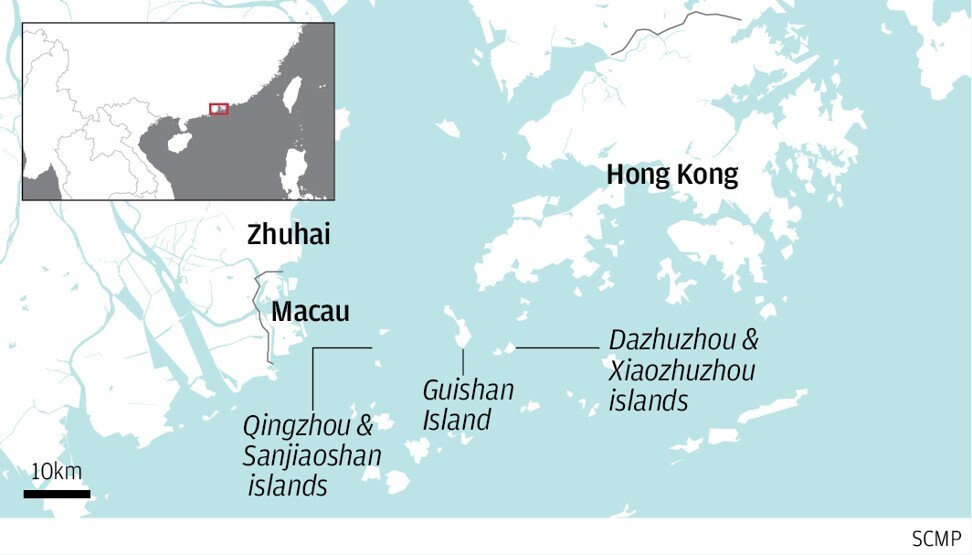
Developers eye Guishan Island’s reclamation to augment Lantau plan in easing Hong Kong’s land woes in test for Greater Bay Area
- The proposal by The Hong Kong Real Property Federation (HKRPF) would reclaim 60 square kilometres of land on several islands around Guishan, and free up the equivalent of 500 hectares of land in Hong Kong for housing 800,000 residents
- The plan had been submitted to city authorities, as well as the government in the Guangdong provincial city of Zhuhai, under which Guishan is administered
A guild of developers and real estate professionals have proposed to reclaim several islands lying in the sea between Lantau Island and Macau to augment the Hong Kong government’s HK$624 billion (US$80 billion) Lantau Tomorrow reclamation project for alleviating the city’s land shortage.
The proposal by the 229-member Hong Kong Real Property Federation (HKRPF), would reclaim 60 square kilometres of land on three sets of islands around Guishan, and free up the equivalent of 500 hectares of land in Hong Kong for housing 800,000 residents, according to a proposal unveiled on Monday. The plan may be handed over to city authorities, as well as the government in the Guangdong provincial city of Zhuhai, under which Guishan is administered.
“By reclaiming land and allocating it in a reasonable manner, the per-capita living area will be increased by 25 to 85 per cent compared to the current situation in Hong Kong,” the HKRPF’s vice-president Victor Sung said on Monday. “A substantial improvement in living space would not lead to an increase in mortgage stress.”
The HKRPF’s members include the Guangzhou developer Yuexiu Property (HK) Company, China Overseas Land & Investment, Hong Kong-based developer K. Wah International Holdings, Shun Tak Development and the accounting firms Deloitte Touche Tohmatsu and KPMG.
The first phase, to be carried out between 2021 and 2030, will comprise a neighbourhood for pensioners, correctional facilities and container terminals in an area covering 20 square kilometres on Guishan, according to the plan. The relocation of prisons including drug rehabilitation centres from Hong Kong is expected to free up 120 hectares of urban land, while that of the container terminal can free up 380 hectares, according to the project’s vision.
The second phase from 2031 until 2040 will reclaim 20 square kilometres on Dazhuzhou and Xiaozhuzhou islands to accommodate up to 200,000 residents in the cultural, creative and education industries. The third phase from 2041 until 2049 will reclaim 30 square kilometres of land around Qingzhou, Sanjiaoshan Island west of Guishan to house 300,000 residents in “future industries” including green construction, and energy-saving technology, the plan said.
A 5-kilometre bridge or undersea tunnel will be built to connect southern Lantau Island with Guishan within five years, before the container terminal is relocated from Hong Kong’s Kwai Chung area to the outer island, according to the HKRPF’s vice-president and research centre chairman Hui Ching.
The reclamation can accommodate as many as 280,000 homes and generate 500,000 jobs in nine industries, where each resident can enjoy between 200 square feet and up to 300 square feet of living space, according to the plan.
That would be welcomed news for Hong Kong residents, where a 600-sq ft subsidised Green Form flat costs HK$3 million, while a same-size unit under the government’s Home Ownership Scheme costs HK$4.5 million, and a Starter Home costs HK$6 million.
While the federation declined to estimate the total cost of the Guishan project, Hui said reclamation work in mainland China seldom exceeds 30 per cent of the cost in Hong Kong, where sky-high real estate prices have contributed to higher costs in everything from material to labour. The cities of the GBA could establish a Guishan Island Investment Fund to finance the construction and development of the project, taking a page out of the financing playbook of Singapore’s Temasek Holdings and the Norwegian government’s sovereign wealth find, said Derrick Yip, vice-chairman of the HKRFP’s executive board. As Guishan currently comes under Zhuhai’s jurisdiction, its government could invest in the fund with land.
The fund could be listed locally, domestically or overseas, as a long-term investment product for institutions, enterprises and individuals. It could be used to promote the diversification of the local financial and securities markets. By allowing local securities trading, the island could provide investors with more funds, bonds and various fixed-income products in addition to public offerings and stocks.
For now, Guishan remains a plan on paper. Myriad practical, administrative and legal questions, and bureaucratic hurdles have to be overcome before the 11 cities of the GBA – covering three different political, currency, regulatory and administrative systems between China, Hong Kong and Macau – can become united under one single jurisdiction.
“It is not feasible,” said Albert Luk, a city barrister. “We cannot send [Hong Kong’s] police officers to execute [Hong Kong law]” in the GBA, which creates a problem on a daily basis, he said.
Hong Kong practises the common law, which is not compatible with continental law practised on the mainland, so “if someone violates the law, how to bring him to justice” is a practical and real issue, with no court in place, Luk said. “I cannot see a concrete proposal now.”


